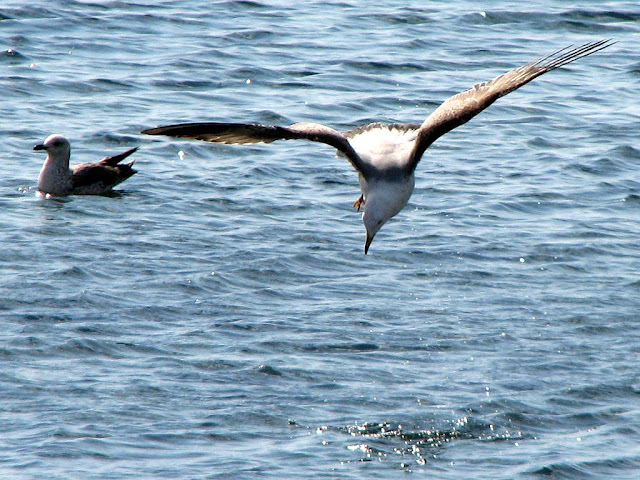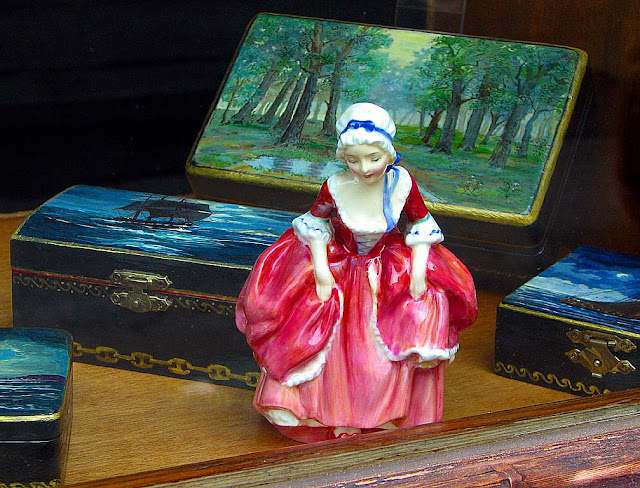 Sailboats at the marina of the Porto Mediceo.
Sailboats at the marina of the Porto Mediceo.
Tuesday, March 31, 2009
Monday, March 30, 2009
Mistral
 This strange boat is the “Mistral”, a tug converted in yacht built by the Benetti shipyard in 1962. On the background you can see the 52 meters tall “Fanale dei Pisani”.
This strange boat is the “Mistral”, a tug converted in yacht built by the Benetti shipyard in 1962. On the background you can see the 52 meters tall “Fanale dei Pisani”. The converted tug is quite an odd product for a boat builder world famous for its wonderful luxury yachts.
The converted tug is quite an odd product for a boat builder world famous for its wonderful luxury yachts.Search labels: tug
Labels:
harbor,
lighthouse,
Livorno,
tug,
yacht
Sunday, March 29, 2009
San Jacopo in Acquaviva
 “Jacopo” is an arcaic form of “Giacomo”, the italian for James, closer to the spanish “Iago” and to the original Hebrew “Ya'akov”. San Jacopo is placed on a small cove along the “Lungomare”, between the “Terrazza Mascagni” and the Naval Academy. The first church was built on a 13th century crypt near a source of spring water called “acqua viva” (literally live water).
“Jacopo” is an arcaic form of “Giacomo”, the italian for James, closer to the spanish “Iago” and to the original Hebrew “Ya'akov”. San Jacopo is placed on a small cove along the “Lungomare”, between the “Terrazza Mascagni” and the Naval Academy. The first church was built on a 13th century crypt near a source of spring water called “acqua viva” (literally live water).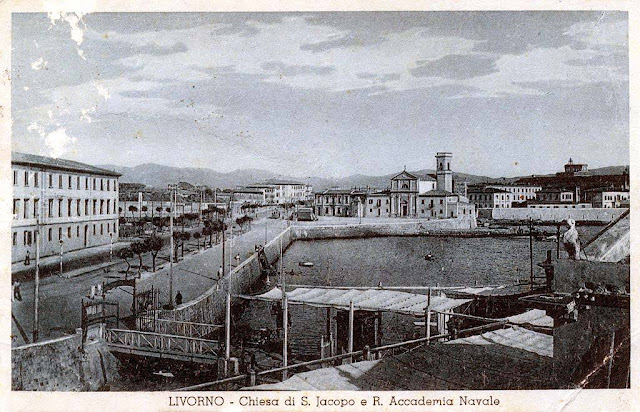 The original construction was enlarged between the 17th and the 18th centuries. The actual building dates to the end of the 19th century. In past times pilgrims sailed from a small pier for the Way of Saint James to Santiago de Compostela in Galicia, Spain.
The original construction was enlarged between the 17th and the 18th centuries. The actual building dates to the end of the 19th century. In past times pilgrims sailed from a small pier for the Way of Saint James to Santiago de Compostela in Galicia, Spain.See also: Terrazza Mascagni
External links: Way of Saint James - Santiago de Compostela (Wikipedia)
Search labels: postcard
Saturday, March 28, 2009
Modigliani's Heads
 This is the “Fosso Reale”, just in front of where I live now, and exactly where 25 years ago took place one of the greatest hoaxes in the history of Italian art. Four high-school students and a dockworker started what was intended as a no more than a practical joke, ending with an earthquake that shattered the reputations of many art critics. If you do not know, or simply do not remember well what happened, please check this link: Modigliani’s Heads (“noresize”, October 25, 2007).
This is the “Fosso Reale”, just in front of where I live now, and exactly where 25 years ago took place one of the greatest hoaxes in the history of Italian art. Four high-school students and a dockworker started what was intended as a no more than a practical joke, ending with an earthquake that shattered the reputations of many art critics. If you do not know, or simply do not remember well what happened, please check this link: Modigliani’s Heads (“noresize”, October 25, 2007). The art historian Federico Zeri, alone, proclaimed that the sculptures were so “immature” that even if they were authentic, Modigliani had been right about throwing them away. I don't know if one day someone will try to dredge the “Fosso” again, but I'm sure that they'll find dozens of heads. Here, in 1984, everybody who could handle a chisel or a power tool and was able to lay hands on a piece of stone, quickly made his personal “Modigliani's head” and threw it in those water.
The art historian Federico Zeri, alone, proclaimed that the sculptures were so “immature” that even if they were authentic, Modigliani had been right about throwing them away. I don't know if one day someone will try to dredge the “Fosso” again, but I'm sure that they'll find dozens of heads. Here, in 1984, everybody who could handle a chisel or a power tool and was able to lay hands on a piece of stone, quickly made his personal “Modigliani's head” and threw it in those water.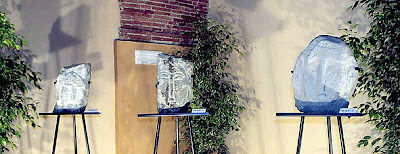 (Fake heads image from: La “beffa” dell'estate 1984)
(Fake heads image from: La “beffa” dell'estate 1984)Search labels: Modigliani
External links: Amedeo Modigliani (Wikipedia)
Labels:
bridge,
canal,
Livorno,
Modigliani
Friday, March 27, 2009
On the Road Again
 On the road again to Montenero: this is not a mailbox of note, but the “complexity” of this composition seemed worthy of publication.
On the road again to Montenero: this is not a mailbox of note, but the “complexity” of this composition seemed worthy of publication.Tomorrow's will be our hundredth post and we should like to celebrate this modest achievement with a very “Livornese” story.
Thursday, March 26, 2009
Fortezza Nuova
 “Fortezza Nuova” is New Fortress, where “new” means the year 1591. It was partly demolished in the 17th Century to make room for the new quarter of Venezia (Venice). The fortress is still completely surrounded by water and now is a public park or, better, it was until last January, when it was closed due to major acts of vandalism.
“Fortezza Nuova” is New Fortress, where “new” means the year 1591. It was partly demolished in the 17th Century to make room for the new quarter of Venezia (Venice). The fortress is still completely surrounded by water and now is a public park or, better, it was until last January, when it was closed due to major acts of vandalism. Probably it will reopen just in time, before the next local elections in June.
Probably it will reopen just in time, before the next local elections in June.See also: Fortezza Vecchia - Inside the Fortress - From the Fortress - Fortress with a Secret - Fortress from the Sky - The Fortress, at Last!
Search labels: Fortezza Nuova
Labels:
Fortezza Nuova,
fortress,
Livorno
Wednesday, March 25, 2009
Three Sets of Eyes
 Here is the “Moby Vincent”, another Moby Lines ferry, with her typical Looney Tunes livery: Bugs Bunny, Sylvester and Tweety are watching something...
Here is the “Moby Vincent”, another Moby Lines ferry, with her typical Looney Tunes livery: Bugs Bunny, Sylvester and Tweety are watching something...Search labels: Moby - ferry
Tuesday, March 24, 2009
Monday, March 23, 2009
Under the Sea
 This is “Life under the sea”, with their version of the Four Moors, as imagined by some students of “Istituto Professionale Colombo” for a mural competition among secondary schools of Livorno.
This is “Life under the sea”, with their version of the Four Moors, as imagined by some students of “Istituto Professionale Colombo” for a mural competition among secondary schools of Livorno.The “exhibition” is on a wall of the Nazario Sauro marina, not far from the “Terrazza Mascagni”.
 Update: they won the competition, so here is their complete work.
Update: they won the competition, so here is their complete work.Sunday, March 22, 2009
Filming on Our Streets
 I don't know what they were filming but they were absorbed and conspicuous, standing in the middle of “Corso Mazzini” yesterday afternoon.
I don't know what they were filming but they were absorbed and conspicuous, standing in the middle of “Corso Mazzini” yesterday afternoon.
Saturday, March 21, 2009
Window with a Heart
 Probably it is not a heart but, please, let me have some poetic licence...
Probably it is not a heart but, please, let me have some poetic licence...The “Peg Man” of Google Maps has just arrived in Livorno: drag him on a street of your choice and voilà!
External links: Google Street View (Wikipedia)
Friday, March 20, 2009
Leghorn “la Cara”
 Many Italian cities have a qualifying adjective dear to their citizen, that at the first blush seems to be a complete misnomer, but that time and study show to be pre-eminently apt and true. Florence is “la bella”, but this you never comprehend until you come to look down upon the city from the heights of San Miniato or Fiesole.
Many Italian cities have a qualifying adjective dear to their citizen, that at the first blush seems to be a complete misnomer, but that time and study show to be pre-eminently apt and true. Florence is “la bella”, but this you never comprehend until you come to look down upon the city from the heights of San Miniato or Fiesole.Lucca is “l'industriosa”, but even after a week's sojourn you rub your eyes and ask if this is not Sleepy Hollow.
Genoa is “la superba”, but her glory is at first sight dimmed by obstrusiveness and omnipresence of the commercial element.
 And Leghorn is “la cara”. Surely no attribute could be glaringly incorrect. And yet let the traveller cease awhile from travelling and take his rest by the Liburnian shore, let him dip in the tonic waters of the Tyrrhenian Sea, and walk by its shores in the cool spring days and warm winter afternoons, drinking in the health-giving breezes and feasting on the glories of the Gorgonian Archipelago, let him mingle freely with the cheery, courteous, contented Livornesi, who dearly love to bid a stranger welcome, and he will see that Time has well named Leghorn “la cara”, and that she is dear indeed.
And Leghorn is “la cara”. Surely no attribute could be glaringly incorrect. And yet let the traveller cease awhile from travelling and take his rest by the Liburnian shore, let him dip in the tonic waters of the Tyrrhenian Sea, and walk by its shores in the cool spring days and warm winter afternoons, drinking in the health-giving breezes and feasting on the glories of the Gorgonian Archipelago, let him mingle freely with the cheery, courteous, contented Livornesi, who dearly love to bid a stranger welcome, and he will see that Time has well named Leghorn “la cara”, and that she is dear indeed.(Montgomery Carmichael, “In Tuscany”
John Murray, London 1901)
John Murray, London 1901)
Montgomery Carmichael was the British vice consul and then consul for the area of Tuscany (except Florence), Umbria, the Marche and San Marino from 1890 to 1922. After retiring, he lived in Livorno until his death in 1936.
The first photo portrays the monument to Ferdinand III, Grand Duke of Tuscany, in Piazza della Repubblica.
The second image is a portrait of the consul found in a copy of a now defunct publication: “La Canaviglia” (from the name of the bastion of the Fortezza Vecchia), a precious source for many of these posts.
Labels:
Carmichael,
Livorno,
statue
Thursday, March 19, 2009
Mailbox
 Fort Lauderdale Daily Photo is posting a funny series of unusual mailboxes. Here, with most of us living in apartment blocks, external mailboxes are not so common in urban areas.
Fort Lauderdale Daily Photo is posting a funny series of unusual mailboxes. Here, with most of us living in apartment blocks, external mailboxes are not so common in urban areas.The few I see around are usually a quite plain thing, with at least an exception on the road to Montenero.
Wednesday, March 18, 2009
Santa Maria del Soccorso
 The decision to build “Santa Maria del Soccorso” came after a deadly outbreak of cholera in 1835, when a group of citizen started raising funds for the construction of a new church to invoke the protection of Saint Mary. Built on a project by the florentine architect Gaetano Gherardi (1799-1891), the temple took over twenty years to be completed, resulting in an imposing structure amidst a 40,000 square meters public park placed on the axis of “Via Magenta”.
The decision to build “Santa Maria del Soccorso” came after a deadly outbreak of cholera in 1835, when a group of citizen started raising funds for the construction of a new church to invoke the protection of Saint Mary. Built on a project by the florentine architect Gaetano Gherardi (1799-1891), the temple took over twenty years to be completed, resulting in an imposing structure amidst a 40,000 square meters public park placed on the axis of “Via Magenta”. The church was spared by the last war and, until the reconstruction of the destroyed Cathedral, it was the heart of the religious celebrations of the Diocese of Livorno. A bell tower was projected but never built. The park became “Piazza Magenta”, then “Piazza della Vittoria”, though everybody still call it by its old name.
The church was spared by the last war and, until the reconstruction of the destroyed Cathedral, it was the heart of the religious celebrations of the Diocese of Livorno. A bell tower was projected but never built. The park became “Piazza Magenta”, then “Piazza della Vittoria”, though everybody still call it by its old name.Tuesday, March 17, 2009
Topless Sphinx
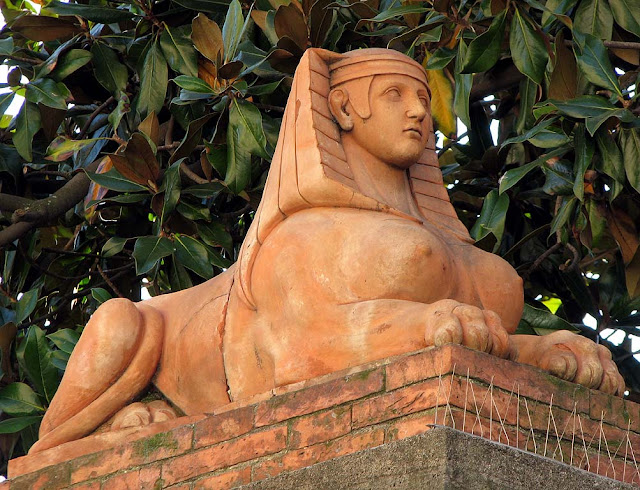 Wikipedia says: In Greek mythology, a sphinx is represented as a monster with a head and breasts of a woman, the body of a lion, the wings of an eagle, and a serpent headed tail.
Wikipedia says: In Greek mythology, a sphinx is represented as a monster with a head and breasts of a woman, the body of a lion, the wings of an eagle, and a serpent headed tail.The unknow “artist” who made this sphinx decided that the eagle and the snake part weren't so important and concentrated himself on the... rest. This terra-cotta sphinx has a twin sister, and both are placed on the back entrance of a famous “palazzo” in central Livorno.
Monday, March 16, 2009
Fallen
 The “Monumento ai Caduti” (Monument to the Fallen) is placed in Piazza della Vittoria (Victory Square) just in front of “Santa Maria del Soccorso” (1859), the largest church in Livorno. This memorial, by the sculptor Mario Carlesi, honors the fallen in World War I and was inaugurated in 1925 at the presence of the King of Italy.
The “Monumento ai Caduti” (Monument to the Fallen) is placed in Piazza della Vittoria (Victory Square) just in front of “Santa Maria del Soccorso” (1859), the largest church in Livorno. This memorial, by the sculptor Mario Carlesi, honors the fallen in World War I and was inaugurated in 1925 at the presence of the King of Italy. On a lower plinth three men rise their swords in a solemn oath under a statue representing the winged Victory. In several occasions every year, solemn wreath-laying ceremonies take place at the monument.
On a lower plinth three men rise their swords in a solemn oath under a statue representing the winged Victory. In several occasions every year, solemn wreath-laying ceremonies take place at the monument.Sunday, March 15, 2009
Villa Azzurra
 The picturesque “Villa Azzurra” is a Liberty style villa in Montenero built in the first years of 20th Century.
The picturesque “Villa Azzurra” is a Liberty style villa in Montenero built in the first years of 20th Century.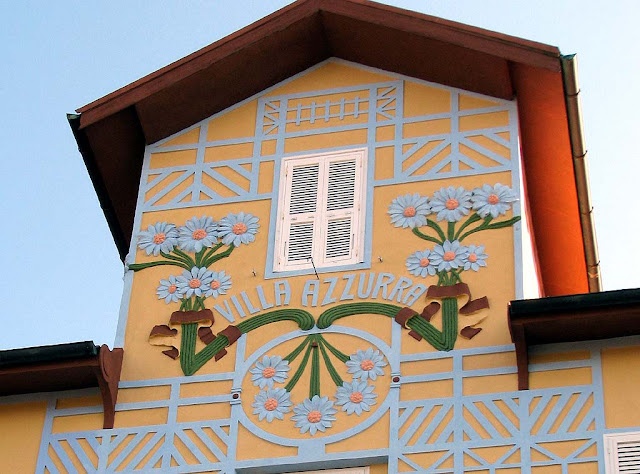 This is an update for this post, I just found this old postcard showing “Villa Azzurra” when it was called “Padiglione Bleu”.
This is an update for this post, I just found this old postcard showing “Villa Azzurra” when it was called “Padiglione Bleu”. The roof was more ornate than now and had several “spires”, but the rest of the building is practically the same.
The roof was more ornate than now and had several “spires”, but the rest of the building is practically the same.See also: Montenero - Sanctuary of Montenero - Funicolare - Sagrato - Famedio - Piazza del Santuario
Saturday, March 14, 2009
Lights
 I have shot this photo just in front of the “Cisternone”: traffic lights against street lights.
I have shot this photo just in front of the “Cisternone”: traffic lights against street lights.
Friday, March 13, 2009
Teatro Goldoni
 The Goldoni Theater or “Goldoni”, as it called informally here, was built on a project of the architect Giuseppe Cappellini (Livorno, 1812 - Firenze, 1876). It was inaugurated as “Imperiale e Regio Teatro Leopoldo” in honor of Leopold II, Grand Duke of Tuscany, on 24 July 1847 with the opera “Robert le diable” by Giacomo Meyerbeer.
The Goldoni Theater or “Goldoni”, as it called informally here, was built on a project of the architect Giuseppe Cappellini (Livorno, 1812 - Firenze, 1876). It was inaugurated as “Imperiale e Regio Teatro Leopoldo” in honor of Leopold II, Grand Duke of Tuscany, on 24 July 1847 with the opera “Robert le diable” by Giacomo Meyerbeer.In 1860, with the unification of Italy, it was renamed “Regio Teatro Goldoni” after the celebrated Venetian playwright and librettist Carlo Goldoni. A Venetian honored in Tuscany needs an explanation: during his many wanderings and adventures in Italy, Goldoni was living in Livorno when, happily for us all, determined to pursue the playwriting as a profession. Years after, he set his “Trilogia della villeggiatura” (Holiday Trilogy) in Livorno, describing a family who crave and then spend a vacation to Montenero, only to return home completely exhausted.
 In more recent times the theater fall into disrepair from the ravages of time and the neglect of the owners, so the municipality exercised its right of eminent domain in 1990, after the building was condemned few years before. The theater, after a long restoration, was inagurated (for a second time) on 24 January 2004 with “Cavalleria rusticana” by the Livorno-born Pietro Mascagni at the presence of the President of the Italian Republic, the Livorno-born Carlo Azeglio Ciampi.
In more recent times the theater fall into disrepair from the ravages of time and the neglect of the owners, so the municipality exercised its right of eminent domain in 1990, after the building was condemned few years before. The theater, after a long restoration, was inagurated (for a second time) on 24 January 2004 with “Cavalleria rusticana” by the Livorno-born Pietro Mascagni at the presence of the President of the Italian Republic, the Livorno-born Carlo Azeglio Ciampi.(architectural model from http://www.goldoniteatro.it/)
Labels:
architecture,
building,
Livorno,
theater
Thursday, March 12, 2009
Pentagon's Spring
 Everybody's posting sprouts and flowers, so I pushed the macro button and shot this photo on my blooming terrace. I grew several succulents and this is one of my favourites, an echeveria pulvinata.
Everybody's posting sprouts and flowers, so I pushed the macro button and shot this photo on my blooming terrace. I grew several succulents and this is one of my favourites, an echeveria pulvinata.Wondering about the title? Probably you missed one of my silliest post: “Inside the Pentagon”.
Wednesday, March 11, 2009
Sanctuary of Montenero
 The “Santuario di Santa Maria delle Grazie” (Sanctuary of St Mary of Grace) has been transformed over the centuries from a small oratory in the Middle Ages to a Renaissance church, and finally to a large Basilica, consecrated in 1818. The long nave incorporates altars from the mid-17th century linked to the old trade guilds of Livorno. The altars have some beautiful paintings by Filippo Maria Galletti.
The “Santuario di Santa Maria delle Grazie” (Sanctuary of St Mary of Grace) has been transformed over the centuries from a small oratory in the Middle Ages to a Renaissance church, and finally to a large Basilica, consecrated in 1818. The long nave incorporates altars from the mid-17th century linked to the old trade guilds of Livorno. The altars have some beautiful paintings by Filippo Maria Galletti. Noteworthy is the 18th century “Cappella della Vergine” (chapel of the virgin) housing the tabernacle with its sacred image of the “Madonna di Montenero”, a 14th century painting from the Pisan school. Around the Basilica the “Galleria dei Comuni” (gallery of the communes) features the coats of arms of all the communes in Tuscany, and the “Galleria degli ex-voto” (gallery of the votive offerings) constitutes an ample collection of devotional paintings offered by the faithful for graces received.
Noteworthy is the 18th century “Cappella della Vergine” (chapel of the virgin) housing the tabernacle with its sacred image of the “Madonna di Montenero”, a 14th century painting from the Pisan school. Around the Basilica the “Galleria dei Comuni” (gallery of the communes) features the coats of arms of all the communes in Tuscany, and the “Galleria degli ex-voto” (gallery of the votive offerings) constitutes an ample collection of devotional paintings offered by the faithful for graces received. These simple paintings are images of people: fishermen, farmers, shepherds, women and children. You can also admire the work of famous local artists: “Il cavallino” (The pony, 1850) by Giovanni Fattori and “Il motociclista” (The motorcyclist, 1943) by Renato Natali.
These simple paintings are images of people: fishermen, farmers, shepherds, women and children. You can also admire the work of famous local artists: “Il cavallino” (The pony, 1850) by Giovanni Fattori and “Il motociclista” (The motorcyclist, 1943) by Renato Natali.See also: Montenero - Villa Azzurra - Funicolare - Sagrato - Famedio - Piazza del Santuario
External links: Sanctuary of Montenero - Filippo Maria Galletti - Ex-voto
Tuesday, March 10, 2009
Amedeo Modigliani
 Amedeo Modigliani was born on July 12, 1884, when Livorno was a thriving commercial port and also a refuge for those persecuted for their religion. His great-great-grandfather was a Jew who had immigrated to Livorno in the 18th century as a religious refugee. His father Flaminio, a money-changer, went bankrupt, forcing his family to live in poverty. Amedeo's birth probably saved the family from certain ruin because an ancient law stated that creditors could not seize the bed of a pregnant woman or a mother with a newborn child. When bailiffs entered Modigliani's home, with his mother Eugenia just into labour, the family piled their most valuable assets on top of her's bed, saving most of them.
Amedeo Modigliani was born on July 12, 1884, when Livorno was a thriving commercial port and also a refuge for those persecuted for their religion. His great-great-grandfather was a Jew who had immigrated to Livorno in the 18th century as a religious refugee. His father Flaminio, a money-changer, went bankrupt, forcing his family to live in poverty. Amedeo's birth probably saved the family from certain ruin because an ancient law stated that creditors could not seize the bed of a pregnant woman or a mother with a newborn child. When bailiffs entered Modigliani's home, with his mother Eugenia just into labour, the family piled their most valuable assets on top of her's bed, saving most of them. The bust in the first photo is placed at the main entrance of Villa Fabbricotti, a park which also hosts the main local library. The plaque is outside the still existing house in Via Roma, now a private museum, and says:
The bust in the first photo is placed at the main entrance of Villa Fabbricotti, a park which also hosts the main local library. The plaque is outside the still existing house in Via Roma, now a private museum, and says:Here received the gifts of
life, genius, virtue
the painter
Amedeo Modigliani
The Municipality of Livorno
in the 75th anniversary of the birth
July 12, 1959
life, genius, virtue
the painter
Amedeo Modigliani
The Municipality of Livorno
in the 75th anniversary of the birth
July 12, 1959
Life and genius are certain, but it seems absurd to me to call our Amedeo a man of “virtue”...
Search labels: Modigliani
External links: Amedeo Modigliani (Wikipedia)
Labels:
bust,
Livorno,
Modigliani,
park,
plaque
Monday, March 9, 2009
Montenero
 Welcome to Montenero (lit. Black Mount), a village on the hills overlooking Livorno and one of its most fascinating suburbs. Montenero is a well known religious centre because of the Sanctuary of “Santa Maria delle Grazie”, patron Saint of Tuscany. The tiny square has a panoramic terrace with a wonderful view of the town and of the coastline: on a clear day you can see the islands of the Tuscan Archipelago.
Welcome to Montenero (lit. Black Mount), a village on the hills overlooking Livorno and one of its most fascinating suburbs. Montenero is a well known religious centre because of the Sanctuary of “Santa Maria delle Grazie”, patron Saint of Tuscany. The tiny square has a panoramic terrace with a wonderful view of the town and of the coastline: on a clear day you can see the islands of the Tuscan Archipelago. From Montenero Basso (Lower Montenero) there is a funicular service reaching the upper village at an elevation of around 280 meters. You can use a car, but for an easy drive you have to take a quite long detour around the hill. So it's probably hard to believe that these roads were part of a racing circuit, the Montenero Circuit, very popular in the 30's. It hosted many international races and the annual “Coppa Ciano”, which the legendary Tazio Nuvolari won five times. In 1937 the Italian Grand Prix itself took place on the circuit and was won by Rudolf Caracciola on a Mercedes-Benz.
From Montenero Basso (Lower Montenero) there is a funicular service reaching the upper village at an elevation of around 280 meters. You can use a car, but for an easy drive you have to take a quite long detour around the hill. So it's probably hard to believe that these roads were part of a racing circuit, the Montenero Circuit, very popular in the 30's. It hosted many international races and the annual “Coppa Ciano”, which the legendary Tazio Nuvolari won five times. In 1937 the Italian Grand Prix itself took place on the circuit and was won by Rudolf Caracciola on a Mercedes-Benz.See also: Sanctuary of Montenero - Villa Azzurra - Funicolare - Sagrato - Famedio - Piazza del Santuario
External links: Sanctuary of Montenero - Montenero Circuit - Coppa Ciano - Tazio Nuvolari - Italian Grand Prix - Rudolf Caracciola (Wikipedia)
Sunday, March 8, 2009
Hair Brushes & Fake Flowers
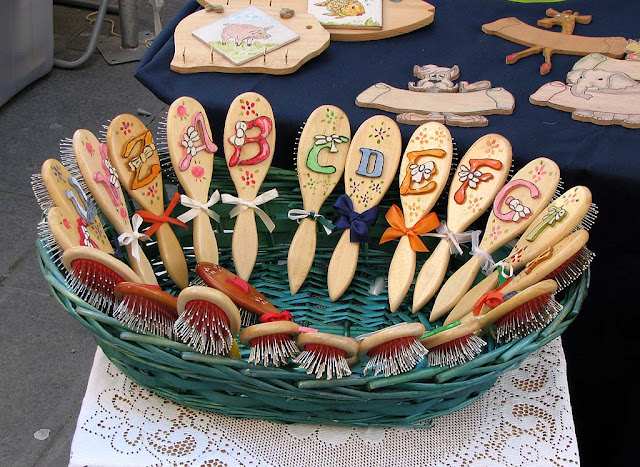 Yesterday, walking home from work, I found some stalls in “Via della Madonna” and just can't resist taking some pictures. A basket of initial personalized hair brushes and a bunch of quite realistic fake flowers are my favorites.
Yesterday, walking home from work, I found some stalls in “Via della Madonna” and just can't resist taking some pictures. A basket of initial personalized hair brushes and a bunch of quite realistic fake flowers are my favorites.
Saturday, March 7, 2009
Fortezza Vecchia
 We have already seen a glimpse of this fortress in my post “Window on the Harbor”. Here you can really get three fortresses for the price of one, which is nothing because the entrance is free of charge.
We have already seen a glimpse of this fortress in my post “Window on the Harbor”. Here you can really get three fortresses for the price of one, which is nothing because the entrance is free of charge.The first one, built between 11th and 12th Centuries, is the round, 30 meters high, plastered tower called “Mastio di Matilde” (Matilda's Keep). Although no proven historical link exists with Matilda of Tuscany, the name of the Countess “has stuck”. The photo of “Bell Tower & Chimneys” was taken from the top of this donjon. The second one is the “Quadratura dei Pisani” (Square fort of the Pisans) built in 14th Century and then enclosed in the huge “Fortezza Vecchia” (Old Fortress) itself, completed in the first years of the 16th Century.
 This red brick fortress has three large bastions: the “Canaviglia” is the one with the residence of the Grand Duke overlooking the port. You can see it on the left in the second photo, the bastion on the foreground is called “Ampolletta”.
This red brick fortress has three large bastions: the “Canaviglia” is the one with the residence of the Grand Duke overlooking the port. You can see it on the left in the second photo, the bastion on the foreground is called “Ampolletta”. The last bastion, heavily damaged during the last war, is known as “Capitana” and is the only part closed to the public, for obvious safety reasons. Various events take place inside the “Quadratura” during the summer and a restaurant is open year round.
The last bastion, heavily damaged during the last war, is known as “Capitana” and is the only part closed to the public, for obvious safety reasons. Various events take place inside the “Quadratura” during the summer and a restaurant is open year round.See also: Piazza dei Grani - Scalo Regio - Porta del Duca - Cortile d'Arme - Capitana - Ampolletta - Molo del Soccorso - Canaviglia - Palazzo di Francesco - Mastio di Matilde - From the Top
Search labels: Fortezza Vecchia
Labels:
Fortezza Vecchia,
fortress,
harbor,
Livorno,
wall
Friday, March 6, 2009
ITN 1
 A rowing boat of the Technical Nautical Institute “Alfredo Cappellini” cruising the old harbor called “Pamiglione”, just in front of the Four Moors. This way students learn basic rowing technique, proper boat handling and safety. They probably have some fun too...
A rowing boat of the Technical Nautical Institute “Alfredo Cappellini” cruising the old harbor called “Pamiglione”, just in front of the Four Moors. This way students learn basic rowing technique, proper boat handling and safety. They probably have some fun too...
Thursday, March 5, 2009
Bell Tower & Chimneys
 The bell tower of the church of San Ferdinando (1716) in juxtaposition with the chimneys of the Agip refinery (1940) just outside Livorno. Both were heavily damaged by Allied bombings in World War II. The church was restored after the war and the plant completely rebuilt in 1950.
The bell tower of the church of San Ferdinando (1716) in juxtaposition with the chimneys of the Agip refinery (1940) just outside Livorno. Both were heavily damaged by Allied bombings in World War II. The church was restored after the war and the plant completely rebuilt in 1950.Wednesday, March 4, 2009
Sine Sole Sileo
 This elaborate sundial decorates the façade of the local Technical Nautical Institute “Alfredo Cappellini” in “Piazza Giovine Italia”.
This elaborate sundial decorates the façade of the local Technical Nautical Institute “Alfredo Cappellini” in “Piazza Giovine Italia”.The Institute has its roots in a Nautical School, established in 1766 by the Grand Duke Peter Leopold of Lorraine for the instruction of seamen. Founded by Decree on 13 December 1863, the school was the first technical institute in the Province of Livorno.
The Latin inscription “sine sole sileo” means that without the sun I am silent. We have already seen something similar in another post about a sundial.
Tuesday, March 3, 2009
Monday, March 2, 2009
Spider-Man & Jaws
 The owner of this seafood shop van surely has a lot of imagination or, at least, he likes borrowing ideas from movies. On the side we have Spider-Man using his spider-webs as a fishing net and the writing says “Blue Sea - Central Market - Livorno”. On the back, just over Jaws, we can read “Blue Sea - Seafood - ...your nightmare!!”.
The owner of this seafood shop van surely has a lot of imagination or, at least, he likes borrowing ideas from movies. On the side we have Spider-Man using his spider-webs as a fishing net and the writing says “Blue Sea - Central Market - Livorno”. On the back, just over Jaws, we can read “Blue Sea - Seafood - ...your nightmare!!”.
Sunday, March 1, 2009
Theme Day: Glass
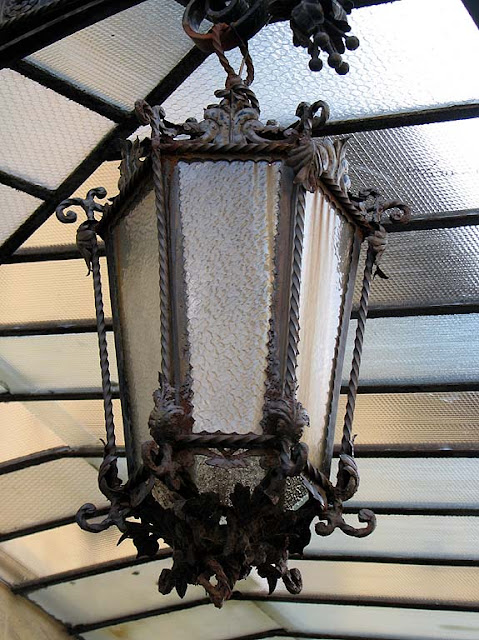 Iron and glass canopy outside the “Istituto Professionale Luigi Orlando”, in Piazza 2 Giugno.
Iron and glass canopy outside the “Istituto Professionale Luigi Orlando”, in Piazza 2 Giugno.I should probably save this one for a future “Iron” Theme Day too...
Click here to view thumbnails for all participants
Subscribe to:
Comments (Atom)

